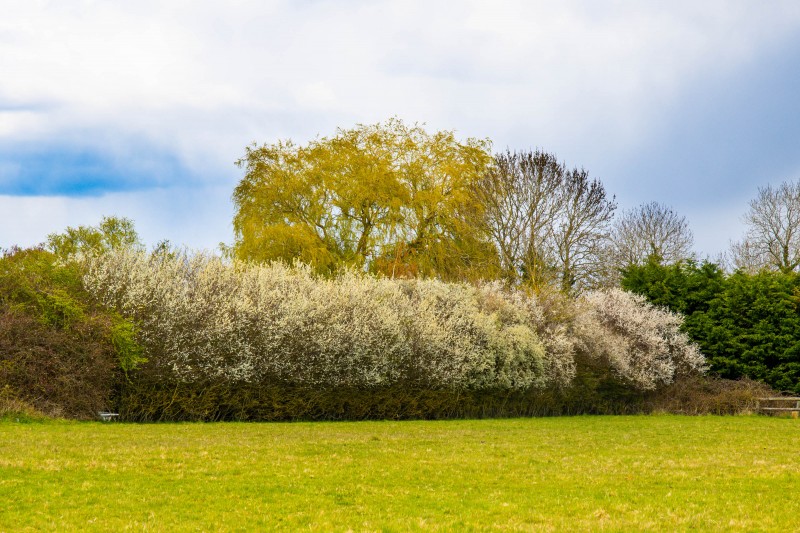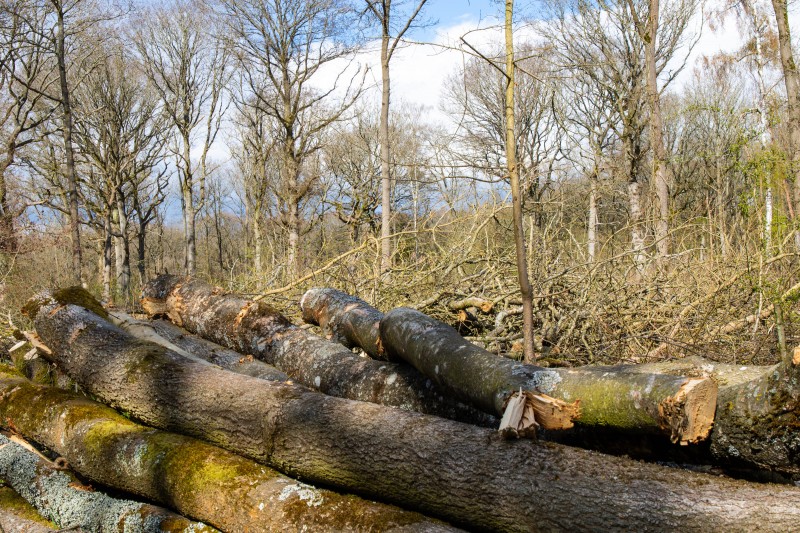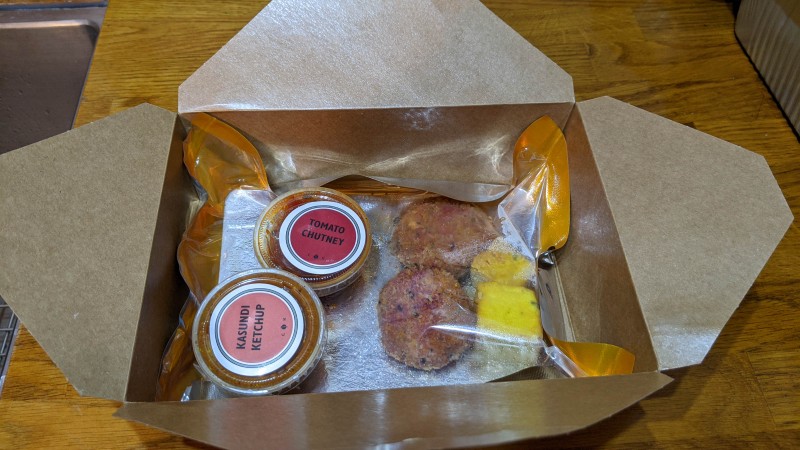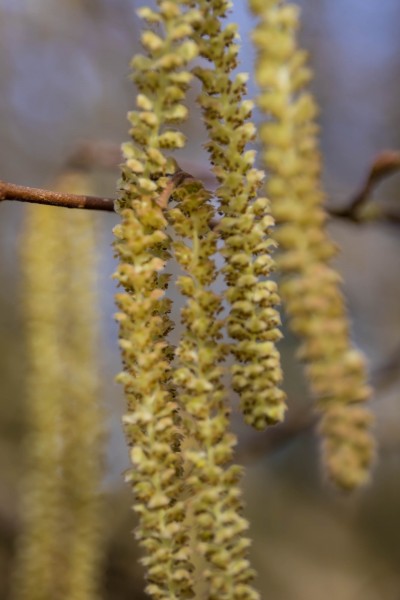The weather has been dry, but cold for many days now. The fields have gone from sodden and waterlogged, to dry and hard. I can hear the farmers complaining about the lack of rain. A few days ago, I went for a short walk around the fields and the local wood to see the lambs and the blossom. The Akeman Inn was ready for the outside dining. Lots of covered areas and large umbrellas with tables. Not open on Sunday 11th, but ready to open on Monday.
Cinnamon Collection
A day of madness and extravagance during the lockdown. We ordered a takeaway from the restaurant chain Cinnamon. Not quite a takeaway, as it takes a day to deliver from London and requires finishing at home. This was a celebration of their 20years of existence. It arrived, and that evening we ate most of it. We were stuffed and never got to the afters. They were reserved for the next day. Extravagant, but really tasty. Not at all like a chicken vindaloo.
The Secret Life of the Compost Heap VIII
Over the last week, our fox has made regular visits to the compost heap come rabbit warren. The fox marked its territory as it left. It must have a route – it walks most nights on the prowl for food. Being a country animal, I suspect the fox has to work harder looking for food, no scraps are thrown out to feed on, it has to survive on fresh meat caught by its own guile and ingenuity.
I have yet to see a rabbit and fox in the same short segment of film. The rabbits certainly do know when to disappear. Thankfully, this fox has become less worried about the infrared light from the camera.
We did not see the fox this week. I hope he/she will be back (along with the polecat and a badger or two). We also had a visit by the night time cat prowler. We still don’t know where this beautiful cat comes from. Would we recognise it in the day time? The black and white infrared pictures make it hard to identify, although R thinks it’s a ginger tabby with white socks.
Stowe Gardens
Stowe Gardens during the third lockdown
After the cold and wet weather, we had a break with sun and a warm 12C temperature. We decided to go for a walk in the local area and drove over to Stowe Gardens. It is that time of year, Snowdrop season. R had booked our arrival time online a couple of days before. We arrived and walked down from the car park. The NT shop, restaurant and loos were of course closed. A small van was selling coffee and light lunches at the entrance. (We had already stocked up with Ginsters Cornish pasty from our local shop.)
A longish walk down the hill to the gardens, where our names were checked. The loos were here, a row of Portaloos. We enjoyed a three-hour walk, with a well-deserved lunch break of Pasty. The Snowdrops were somewhat a disappointment, there were clusters of them, but not the huge waves of them there were a few years back.
We met a man and wife taking pictures of the snowdrops with a background of the Temple of Ancient Virtue. He was using a 4×5 Walker Camera. I believe he could adjust the angle of the photographic plate to reduce converging verticles and change the plane of focus. At least he doesn’t have hundreds of images to choose from when doing his final edits.
The Secret Life of the Compost Heap VII
It has been several weeks since the last Secret Life of The Compost Heap post video. There has been a lack of subjects. I moved the camera to a new location for a week and recorded nothing but rabbits. Back at the compost heap, and the odd fox and badger. It was cold, so maybe they were keeping out of the cold, snuggled down somewhere.
After filming a few scenes of the rabbit hole, I repositioned the camera to look to the left of the rabbit hole where there is a wildlife path. Sure enough, badgers and foxes passed by. The foxes walking by and investigating the second entrance to the rabbit burrow. The foxes are rather camera-shy and can see the Infra-Red light. You can see one small fox being very hesitant. Alas, the Polecat has not been seen again. One domestic cat comes by regularly.
During the day one of our pheasants came by walking towards the bird feeders. You can see him run back a little later. Somebody must have opened the doorway to the house and scared him.
There is a short scene with a little field mouse. Cute.
The Secret Life of the Compost Heap VI
The Secret Life of the Compost Heap VI
The disappearing Polecat (Mustela putorius), hungry fox (Vulpes vulpes), Badger (Meles meles), Rabbit (Oryctolagus cuniculus), Field Mouse (Apodemus sylvaticus)
Where has our polecat (Mustela putorius) gone? We have not seen it for over a week. For several days it came out and played, and now he has gone. I start this video with a short recap of last week’s video. There is the polecat rolling on the ground, he spots the fox and then with fear backs into the hole. You see the fox smelling the ground around where the polecat had rolled. Mr Fox then leaves, coming back at 7.55 in the morning and going straight underground. The new video images start, and you see Mr Fox rush out at 13.47.
We never saw the polecat again; we fear Mr Fox has had a polecat breakfast.
During the rest of the week, Mr Fox and Brock the Badger made appearances, including a very wet Badger during the overnight rain.
A beautiful (??) cat paid the compost heap a fleeting visit. We have seen her before, we don’t know which Humes she owns.
I moved the camera to the other hole last night, not much other than rabbits, and a cute mouse. I removed the card just as the snow had started, and there is an image of a rabbit in the snowfall.
The Secret Life of the Compost Heap V
For the last week, we have been trying other locations for the camera trap to find where our animals were visiting.
The first area was nearby the garden pond, I spied a well-trodden trail and set the camera up there. Mr Fox would run through here coming and going, possibly leaving our neighbours chickens and looking at the compost heap. The next area in the garden was by the woodshed, this showed rabbits and nothing more. Mr Fox though seen heading in that direction did not appear to visit these rabbits.
The final new location was by the field pond. I tried a couple of locations, looking in at rabbit holes. We mainly saw rabbits and brief glimpses of the fox as it was making its way quickly from one area to another. The odd bird would also appear during the daylight. After a complaint by one viewer about the lack of rabbits, I have included a rabbit. It is said that in nature counts, the rarest animals and birds are indeed the most populous. People count the rare species and ignore the pesky rabbits and pigeons
After this, we went back to the compost heap and were treated to some excellent shots of the polecat and fox. In one shot you can see the polecat seeing/hearing the fox and quickly reversing back into the burrow. The fox is keenly interested in the scent of the polecat, sniffing where the polecat had been rolling and examining the rabbit warren.
One disturbing image was the fox going into the hole where the polecat lives just before dawn, and not materialising. Thankfully there are several exits in the compost heap. Maybe he exited somewhere else. I could do with a couple more camera traps to stake out all the other major holes in the compost heap. Did the fox stay over during the day, or did he leave by another hole?
We think we have a couple of foxes at least. There are different muzzle markings and leg markings. One at least is a male because on a previous video you can see him cocking his leg. All the foxes look fit, nimble and quick and don’t hang around for long. They do alas see the camera trap, but do seem to be getting used to it now.
The Secret Life of the Compost Heap IV
Instead of filming the actual compost heap, I decided to film the approaches to it. I scouted out several tracks, one in the wood and one by the garden pond. There was not so much activity in these areas. In the wood we saw rabbits, pigeons, the badger and foxy.
The fox definitely saw the low glow lights on the camera and was somewhat disturbed by them. They are infrared but do glow very slightly red. Foxes apparently do see into the infrared and the lighting does disturb them. You can see the fox staring directly at the camera. The badger does not take a great deal of notice.
These three days of filming did not show much. I will do one more day by the pond, and then move onto another location.
The Secret Life of the Compost Heap III
The same Compost Heap, different rabbit hole. Tonight we were visited by the cute Polecat, a member of the Mustelid family. The Polecat rolled around the ground where a rabbit had been digging. Was it trying to disguise its scent? The previous night was a mystery, the camera failed to operate for some reason.
We have recently been wondering where all the rabbits had gone. Over Summer the grassland around our house had been inundated with rabbits. Since the autumn the number of rabbits has reduced. Even Garden Bunny who I reported on in October has vanished. A tasty morsel for the Polecat, or Mr Fox?
The Secret Life of the Compost Heap II
Another night and the same compost heap, but a different set of starring animals. The Rabbits and Mouse appeared and hogged the camera. They made a hasty getaway when the starring animals appeared, a Fox and a Polecat. The Polecat appeared out of the rabbit hole, and later at the end can be seen rushing back in. The Fox stood and looked at the camera. The later images are poor because of a light frost covering on the lens.













































